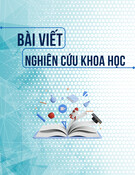
ISSN 1859-1531 - TẠP CHÍ KHOA HỌC VÀ CÔNG NGHỆ - ĐẠI HỌC ĐÀ NẴNG, VOL. 23, NO. 4, 2025 69
AUTOBIOGRAPHICAL ELEMENTS AND REPORTAGE CHARACTERISTICS
IN SELECTED SHORT STORIES OF NGUYEN THI THUY VU
YẾU TỐ TỰ THUẬT VÀ CHẤT PHÓNG SỰ
TRONG MỘT SỐ TRUYỆN NGẮN CỦA NGUYỄN THỊ THUỴ VŨ
Nguyen Van Minh Tri*
The University of Danang - University of Science and Education, Vietnam
*Corresponding author: tri2806037@gmail.com
(Received: March 18, 2025; Revised: March 31, 2025; Accepted: April 14, 2025)
DOI: 10.31130/ud-jst.2025.143
Abstract - Several short stories by Nguyen Thi Thuy Vu are
frequently inspired by her own life experiences. The realistic
portrayal of life in Southern Vietnam is also reflected through the
author's perceptions of the private fates of female characters.
Therefore, examining the autobiographical elements and reportage
characteristics in Nguyen Thi Thuy Vu's short stories contributes to
affirming the significance of personal experiences in her creative
journey and emphasizes the distinctive features of female writing.
This article focuses on analyzing the imprints of personal life in her
literary works, the reflection of social groups' lifestyles, and the role
of the narrator in expressing autobiographical and reportage
qualities in the female author's short stories.
Tóm tắt - Một số truyện ngắn của Nguyễn Thị Thuỵ Vũ thường
lấy cảm hứng từ chính cuộc đời bà. Bức tranh hiện thực đời sống
miền Nam Việt Nam cũng được nhà văn phản ánh từ những cảm
nghiệm về số phận đời tư của các nhân vật nữ. Vì thế, quan tâm
đến yếu tố tự thuật và chất phóng sự trong truyện ngắn Nguyễn
Thị Thuỵ Vũ là hướng đi góp phần khẳng định ý nghĩa từ những
trải nghiệm cá nhân đến hành trình sáng tác và nhấn mạnh nét độc
đáo riêng trong lối viết nữ. Bài viết tập trung phân tích dấu ấn đời
tư cá nhân trong sáng tác đến phản ánh đời sống sinh hoạt về
nhóm người trong xã hội và vai trò của người kể chuyện trong
việc thể hiện tính tự thuật và phóng sự trong truyện ngắn của nữ
nhà văn.
Key words - Short stories; autobiographical elements; reportage
characteristics; narrator.
Từ khóa - Truyện ngắn; yếu tố tự thuật; chất phóng sự; người kể
chuyện.
1. Introduction
Nguyen Thi Thuy Vu was a prominent female writer in
South Vietnam from 1954-1975, notable for her writings on
the status of women in Vietnamese society. The author's
literary works reflect her experiences of life and its
principles, leaving readers with profound reflections on
personal identity when confronted with challenges and
temptations of contemporary circumstances. She boldly
ventured into obscure territories, illuminating them with
compassion for women who daily face pain, trauma, and
loneliness in a disorienting world. Reading Nguyen Thi
Thuy Vu's short stories, one can discern glimpses of her own
life interwoven throughout each narrative. Her characters
include English teachers and young women working in
snack bars. The social tableau depicted in her writing mirrors
the society of South Vietnam during that period.
Consequently, several of Nguyen Thi Thuy Vu's short stories
exhibit autobiographical elements and reportage
characteristics. Literature is not merely fictional text;
realistic material - the author's experiences and sensitivities
to life - also becomes an abundant source of creative
inspiration. This contributes to establishing the writer's
distinctive style. Examining the autobiographical elements
and reportage characteristics in selected short stories such as
One Afternoon (Một buổi chiều), Manh (Mãnh), Golden
Afternoon Light (Nắng chiều vàng), Rushing into Fire (Lao
vào lửa), The Bed (Chiếc giường), Night Cat (Mèo đêm),
Poisonous Tree Without Fruit (Cây độc không trái), and Vast
Darkness (Đêm tối bao la) published in the collections Night
Cat (Mèo đêm), Rushing into Fire (Lao vào lửa), and Vast
Afternoon (Chiều mênh mông) by Nguyen Thi Thuy Vu from
the perspectives of personal life to realistic social portrayal
and narrative technique will help affirm the creativity in her
artistic journey and provide insights into issues of human
condition.
2. Content
2.1. Overview of prose with autobiographical elements
and reportage characteristics
• Autobiography - A Creative Method of Modern Writers
Autobiography is a term established by Serge
Doubrovsky in 1977. “Tự” means self-narration, and
“thuật” means to recount; thus, autobiographical prose is a
literary form of self-narration about one's own life. In the
article The Relationship Between Autobiography - Novel
and Some Forms of Self-Narrative in Contemporary
Vietnamese Literature, Do Hai Ninh defines it as “a genre
in which writers fictionalize themselves, based on
biographical elements to construct a persona different from
their actual self, blurring the recognition of truth” [1].
Therefore, some characters in autobiographical works do
not necessarily bear the author's real name; rather, the
author “borrows” materials from real-life experiences that
they have directly encountered to create their work.
Sometimes, autobiographical works merely contribute an
element that offers a perspective, a feeling, or an
understanding about life's principles derived from the
transformations in the writer's actual life experiences.
In general, autobiography serves as a creative method
that both innovates and sketches a portrait of the individual

70 Nguyen Van Minh Tri
and the era. Do Hai Ninh has identified various forms of self-
narration, clarifying the trend of autobiographical novel
writing - a form of self-narration in the following directions:
“Novelizing one's life story, where the plot is closely related
to biographical details of one's life/ Novelizing biographical
details and personal experiences” [1]. Additionally,
“autofiction” bear similarities to the author's biography. The
creation of autobiographical works involves various
approaches, depending on the writer's artistic intentions.
This contributes to establishing the writer's creative style and
is minimally influenced by the concept of reflecting
objective reality through the artist's subjective world.
Alongside general creative approaches,
autobiographical prose yields various artistic effects. The
choice of narrative perspective also shows clear differences.
In addition to mainstream narrative trends, autobiographical
prose yields notable artistic effects. One clear distinction
lies in the narrative voice: the author may choose a first-
person narrator (“I”) or employ an impersonal third-person
narrator. Using multiple narrative perspectives serves to
“blur” the factual nature of the work, while also bringing
readers closer to the text as if immersing them into a
comprehensive picture of life to search for its meaning.
While reading works in the reportage genre, where real
events and the author's personal imprints serve as guiding
principles throughout the writing process, autobiographical
prose often requires readers to possess a certain breadth of
knowledge about the author's life as revealed through
articles and interviews in order to fully appreciate the
realistic portrait of life that the author has experienced.
• Reportage characteristics - Genre intersection
The concept of reportage emerged in the early 20th
century as part of the modernization movement in
literature. Reportage reflects objective, authentic events
occurring in everyday life that the artist directly
experiences and witnesses. However, sometimes reportage
is conducted by recording accounts heard from others -
called “chamber” reportage. For a work to be classified as
reportage, it must first reflect a specific subject with broad
spatial and temporal dimensions, directly related to the
lifestyle of a certain segment of people in society.
Therefore, reportage always emphasizes realism, as well
as fully and truthfully reflecting what the artist personally
witnesses during field trips. Despite being a literary genre,
reportage has faced considerable debate regarding its
literary nature. Research shows that scholars divide
reportage into two main categories: literary reportage and
journalistic reportage. Due to the close relationship
between reportage and journalism, there is generally an
intersection between these two aspects. Some view
reportage as documentation that completely respects the
facts occurring in life, like a photograph or direct video
recording. Others focus on the literary quality (as Tran
Huu Ta notes) of this genre. Consequently, reportage is
both a genre rich in realism and literary qualities,
expressed through various artistic elements such as
literary techniques, character development, emotionally
rich language, vivid imagery, and more. Nevertheless,
these artistic elements do not diminish the objective reality
of the subject matter; rather, they make the subject more
vibrant and associative, strongly imprinting the author's
creative mark.
Vu Trong Phung was the first writer to whom literary
theorists and critics paid attention regarding the dual
nature between novel and reportage. The “king of
reportage” from the North recreated a Westernized portrait
of the lifestyle of “pseudo-intellectual” elites who, upon
contact with Western civilization, caused tragicomic stories
within society. His novel “Dumb Luck” (Số đỏ)
documented vices, flaws, and moral degradation.
Similarly, “Prostitution” (Làm đĩ) addressed the situation
of young girls who prematurely entered harmful paths to
satisfy sexual desires, resulting in unpredictable
consequences that suppressed individual consciousness
and values. Vu Trong Phung's reportage-colored novels
were individualized when describing specific characters -
who could be viewed as representatives of groups of people
who were products of the era in which the author lived. His
reportage-style novels functioned like videos recording
scenes of life, with characters who were not embellished
but emerged from reality like living organisms.
The short story genre is exceptional, not only in terms
of length but also in its method of reflection. What short
stories express is not merely a slice of life, nor should they
be conceptualized as small excerpts from a novel. Rather,
they contain their own distinct aesthetic ideals, often
embodying the spirit of an era. Exploring reportage
elements within short stories contributes to enriching
literary life and demonstrates the unique storytelling
artistry of writers. This approach expands research
directions by allowing works to be approached from
multiple perspectives.
2.2. Manifestations of autobiographical elements and
reportage qualities in Nguyen Thi Thuy Vu's short stories
2.2.1. Personal life imprints - A distinctive feature of
autobiographical elements
Nguyen Van Trung once addressed the personal life
inspiration of writers in their creative process, stating: “A
true writer always seeks the vibrant spring of their own life
experiences. And authentic life experiences are always
uniquely personal, thus always requiring expression
through specially personal forms, as if they had never
existed or been seen before” [cited 2, p. 60]. As a female
writer, Nguyen Thi Thuy Vu approached literature as a way
to engage with life, revealing its complexities. Her works
are deeply infused with life experiences, focusing
primarily on women's fates. As time passed through
seasons of change, through hearts stirred by nature's
wonders, Nguyen Thi Thuy Vu's artistic world represents a
soul colliding powerfully with life to discover profound
values about living. Writing was her way of being authentic
with herself. For this author, literature wasn't about
painting an idealized, unrealistic life, but rather about
reflecting on life's meanings, on existence alongside
aspirations and the thirst for living.
According to Nguyen Thi Thanh Xuan in her article
“Nguyen Thi Thuy Vu has returned” (Nguyễn Thị Thuỵ Vũ
đã trở lại) published in the book “Sending a Bit of

ISSN 1859-1531 - TẠP CHÍ KHOA HỌC VÀ CÔNG NGHỆ - ĐẠI HỌC ĐÀ NẴNG, VOL. 23, NO. 4, 2025 71
Affection - Literary Portraits” (Gửi đây chút duyên tình
đọc), the female writer once shared that “70% of her stories
are true stories” [3, p. 171]. Therefore, each page of her
writing contains stories about the lives of individuals who
lived in a highly turbulent society. Realism permeates each
character as they collide powerfully with life. The central
subjects in Nguyen Thi Thuy Vu's short stories are women.
Their lives experience many ups and downs, through
emotional wounds, through aspirations about the seeds of
life that ignite a thirst for love and living. But human life is
inherently challenging; they constantly face significant
challenges when their living environment somewhat
contradicts the desires they harbor inside.
Autobiographical writing doesn't necessarily mean
directly narrating the writer's life, but rather creating
artistic images that closely relate to one's own life
experiences, as we affirmed in section 2.1. This is evident
throughout Nguyen Thi Thuy Vu's short stories. The
author's life journey involved growing up in both rural and
urban environments. Characters in her short stories are
people who lived in rural villages from childhood, and
upon reaching adulthood, yearned to escape their sorrows
and “early clouds, late lamps” to step toward new horizons.
Nguyen Thi Thuy Vu herself left her hometown of Vinh
Long for the city, grasping at hope for a changed life. She
eventually realized that life isn't as glamorous as imagined,
but rather consists of multiple shades, sometimes murky
and smudged colors stretching across each person's
existence. It can be observed that in the short story One
Afternoon (Một buổi chiều), the first-person narrator
departs from her rural homeland for the city. Life in this
new land appears distant and detached from reality. In the
countryside, she had longed to begin a renewed life—one
that would liberate her from a monotonous existence
marked by unrelenting sorrow: “I must leave, leave this
house, my life will change” [4, p. 17]. Confronted with the
harshness of reality, the narrator finds herself alone and
disoriented, as “my rustic awkwardness did not fit with the
vibrant unfamiliarity of this colorful Saigon” [4, p. 19],
upon setting foot in this new space. As in “One Afternoon”
(Một buổi chiều), the first-person narrator in the short story
Mãnh is a female teacher residing in the vast urban space
of Saigon. During a return to her rural hometown for the
Lunar New Year (Tết), the narrator is drawn into a stream
of memories-recollecting days spent with friends and
stories of her village’s past-evoked by a chance encounter
with Manh, a fellow villager, on a bus journey. Upon
returning to the city, her life seems excessively peaceful -
a flatness that becomes suspect as life remains incomplete:
“My mind is disturbed by complicated thoughts, questions
scattered throughout books... Life is so long” [4, p. 56].
Women's lives are inherently full of hardship; as beauty
fades, time becomes an endless sorrow, wandering familiar
grounds as they sink deeper into “the familiar river, weary
of the silent life of the neighborhood and in cold illusions?”
(Vast Darkness) (Đêm tối bao la) [5, p. 27]. Thus, female
characters become disgusted and nauseated by stagnant
lives in desolate villages, longing for departure toward
more vibrant existence. In one sharing, the female writer
believed all literary works contain imagination, “but what
imagination doesn't originate from some part of truth?” [6,
p. 49]. For this reason, characters in her works are
bewildered by the urban prosperity, a life that doesn't
belong to them, while memories of the distant past continue
to echo in moments of solitude.
Leaving the provincial town of Vinh Long for the city,
coming from a family with literary tradition and possessing a
certain English proficiency, Nguyen Thi Thuy Vu became an
English teacher at the Vietnam-American Association. Her
time living in the urban environment allowed her to meet and
teach English to young women working in snack bars serving
American soldiers. She listened to the life experiences of
these women who surrendered their bodies to men's caresses
and touches, ultimately compromising themselves by
depending on physical relationships as a remaining salvation
amid their precarious lives. In several of her short stories, the
main characters are often English teachers hired to teach
women who immerse themselves in nightlife entertainment.
In the short story “Golden Afternoon Light” (Nắng chiều
vàng), the narrator is hired as an English tutor for Mi-sen-a
country girl whose rustic given name, Gam, reflects her rural
origins. Having left her hometown for the city, Mi-sen is
illiterate, unfamiliar even with the Vietnamese national script.
She hires the narrator to teach her English, not out of
intellectual curiosity, but as a practical tool for
communicating with her American lovers-her aim being to
extract money from them: “The old Gam is long gone... What
remains now is a certain Mi-sen, someone with a bit of a
reputation in the city’s pleasure circles” [4, p. 66]. These
English teachers often harbor quiet reflections on the human
condition, marked by inner turmoil and a capacity for self-
examination. They sigh, disheartened by the fragility of life:
“I thought again of the nights she sat at her vanity, carefully
examining shades of powder and bottles of nail polish” [4, p.
66]. Through constructing the character of the English
teacher, the writer wants to speak about the dark lives she had
witnessed firsthand, had conversed with, had understood the
fragmentations of women's lives. Looking at these girls, the
teachers reflect on their own lives, which are also full of
solitude, also sighing along life's journey. English becomes a
tool for survival. Two people from different life paths mirror
each other's hidden corners, leading to melancholy and
anxiety about reality. Life stretches long ahead, with infinite
space and the horizon of time. Nguyen Thi Thuy Vu seems to
project her own perceptions of life, resulting in an emotional
response to her gender and to experiences from reality that
enter her works as a dialogue with life and with readers about
the sensitive soul of a heart that beats with life.
Writing is sharing with life. Nguyen Thi Thuy Vu
turned to literature as verses of life on her journey to
transform fate. The days the writer lived and received many
upheavals from her own life and the people she met left
deep impressions in her mind as concerns and wistfulness
about women's lives. Going through ups and downs, at
times, it seemed as if she was surrendering her fate to the
natural course of things. Although the endings of her
stories may not be complete, generally, the lives of her
characters, despite flying into storms, still turn their heads
to glimpse the light flickering within the fluffy white
clouds drifting across the blue sky.

72 Nguyen Van Minh Tri
2.2.2. Reflecting the social life of groups in society - a
“reportage” film of the era
Nguyen Dinh Tuyen evaluated the temporal quality in
Nguyen Thi Thuy Vu's works as follows: “Nguyen Thi Thuy
Vu's stories are truly bold. After reading her stories, I believe
these are the narratives that present the most authentic living
events of our era. This era will eventually pass. Whatever
belongs to this time, if not recorded promptly, will be lost
tomorrow” [7]. Reading Nguyen Thi Thuy Vu's short stories,
one finds them resembling novels of human life condensed
into each word and phrase. Nguyen Thanh Thi identified a
model of “novelization” in short stories characterized by
“expansion and continuation, featuring the reappearance of
characters and settings” [8, p. 14]. When examining several of
Nguyen Thi Thuy Vu's short stories, we observe
interconnection and continuity through the recurrence of
similar character types, such as young women working in
snack bars, harboring spiritual sorrows while feeling exposed
in their physical existence. The settings frequently appear in
familiar locations such as snack bars, private rooms, with
darkness enveloping the scenery. Within these spaces, each
character works in “the same profession” and shares common
fate elements. Therefore, examining the reportage quality
present in short stories with novelistic tendencies in Nguyen
Thi Thuy Vu's prose is entirely feasible.
In one sharing session, Nguyen Thi Thuy Vu expressed
her perspective on women writers: “The Vietnamese
literary scene greatly desires female writers who immerse
themselves in life, seeking materials for creative work. One
must accept society and find inspiration within it” [2, p.
456]. Consequently, perceptions of social life with various
classes of people appear vividly through each theme in her
short stories. The common element is proximity to and
encounter with real life that the writer herself contemplated
through her sensitivities toward reality. The social
landscape of South Vietnam during the 1954-1975 period
differed in political systems compared to North Vietnam.
Within the living spaces of South Vietnamese people at that
time, American and Western European cultural elements
began penetrating society. The reception of the American
lifestyle led to two consequences. On one hand, it
represented a modernizing acceptance that kept pace with
contemporary trends; on the other hand, “the presence of
Americans - beyond military personnel- included
diplomatic staff, economic advisors, construction
contractors building roads, bridges, culverts... Americans
brought with them American currency, American lifestyles,
American cultural products, etc. This was the cause of
many profound changes in South Vietnamese society. The
lifestyle of Americans, especially American soldiers,
fostered the development of entertainment venues and
social vices such as snack bars, prostitution, dancing
girls..., and proliferated drug addiction and organized
crime” [9, p. 25]. Subsequently, for a time, gangster
phenomena and playboys dominated Saigon society.
Prostitution appeared with high density at snack bar
venues catering to American soldiers, representing the most
distinct element in depicting the reality that the author shared
with women working in these establishments. As mentioned,
she was an English teacher, and these young women studied
foreign languages to communicate with American soldiers.
Nguyen Thi Thuy Vu herself had spent time interacting with
these women. They were victims of physical and spiritual
alienation in their struggle for survival and pursuit of love.
While their lived reality was faded, obscured, and deeply
hidden in darkness, Nguyen Thi Thuy Vu, through her artistic
talent, brought them closer to readers to provide a perspective
on the stories behind the bar lights - stories containing
persistent sadness followed by traumatic consequences that
slid down the slope of life. These were women in their
twenties, with beautiful dreams and innocent simplicity that
quickly became stained with dark mud, restraining their steps
in search of life, gradually plunging into bodily pursuits. In
“Rushing into Fire”, Lan transforms from an innocent girl
entering the world of physicality, moving from initial
bewilderment to “conceiving” herself as a full-fledged
professional who must abandon her self-identity. The
rationality and emotions of these young women quickly
hardened to everything. Their days consisted of extracting
money from American soldiers in Saigon. Their living space
was condensed in suffocation and uncertainty; thick like
molasses candies stuck together beyond untangling. The
temptations of pleasure beckoned these women away from
their aspirations and virtues, accepting self-commodification
for the ugliness, baseness, and falsity of life - filling the
painful, harsh reality that could hardly heal their wounds. The
character Tam in the short story “The Bed” compromises
with cruelty and brutality, ready to kill the fetus in her womb
while thinking, “Ten years in this life has eroded all her faith
in life and morality. Karmic retribution seems too distant for
her” [10, p. 17]. Her existence was confined to the bed
alongside American soldier lovers who came and went,
leaving emptiness and fear of fading beauty. ove for these
women was awkward - sometimes passionate, sometimes
wild, but occasionally representing dreams of “reforming”
their lives: “Loan waited aimlessly, while waiting for
something unexpected to arrive and change her way of life”
(Night Cat) (Mèo đêm) [4, p. 92]. And in “The Poisonous tree
without fruit” (Cây độc không trái), after numerous
encounters in bed, the narrator reflects on her life: “I must
look back at my situation! I must look back at my situation! I
have been anxious, and heavy sleep comes, then the next
morning, I calmly face life” [5, p. 127].
Abortion was also an issue the author addressed in her
short stories. This problem stemmed from snack bar girls
who, after nights of “intimacy” with American soldiers, were
left with fatherless pregnancies. The hardships of life coupled
with loneliness drove these women to coldly decide to end
their children's lives. Human compassion retreated, giving
way to unbridled pleasure or worldly sorrows deeply
embedded in the minds of these women. The nightlife with
flickering lights alongside Western liquor seemed to
stimulate human pleasure. Instinctual humanity triumphed
over rational humanity in the vast darkness. The result was a
forming fetus abandoned: “During my first abortion, I was
terrified to the point of madness. I kept thinking: a potential
human life will soon leave my body, making me anxious and
shudder as if narrowly escaping execution” (The Poisonous
tree without fruit) (Cây độc không trái) [5, p. 115].

ISSN 1859-1531 - TẠP CHÍ KHOA HỌC VÀ CÔNG NGHỆ - ĐẠI HỌC ĐÀ NẴNG, VOL. 23, NO. 4, 2025 73
Disregarding life caused the character Tam to become
increasingly indifferent toward human souls, even her own
flesh and blood: “A month after the abortion, Tam regained
her rosy complexion. She felt no trace of worry or unease like
during her first abortion” (The Bed) (Chiếc giường) [10, p.
17]. Even rural girls who came with aspirations of love, after
moments of intimacy, were abandoned by men with a human
form rising in the mother's womb then disappearing, leaving
her to “startle, feeling like a murderer. In the future, in the
underworld, I alone will bear this sin. Even more sinful is that
initially I felt no remorse from conscience” (Vast Darkness)
(Đêm tối bao la) [5, p. 50]. Abortion was illegal in South
Vietnamese society before 1975. Human needs and unsafe
abortion services appeared frequently, becoming a hotspot for
misguided girls seeking to terminate their children's lives. In
addressing abortion, Nguyen Thi Thuy Vu recreated the
social conditions that pushed these risks, while also raising
questions about human ethics and existence. These women
were victims of a period with significant exposure to new
cultures, but lack of understanding led to serious
consequences. The author raised contemporary issues about
the right to life, freedom, and self-determination connected to
human nature that today's society is reconsidering as it begins
new steps in the integration process.
Thus, Nguyen Thi Thuy Vu's reportage style
individualized stories; the author deeply understood life,
listened to intimate, private stories, and penetrated the
pathways of the heart to examine women's entire lives. As a
female writer who herself left her homeland early for urban
life, she experienced life's hardships firsthand. Within each
snack bar girl's life, there were moments when they kindled
glimmers of hope about life, feared the passage of time,
worried about fading beauty, and yearned for a happy home
and complete love - like a singular remedy that could return
them to their true selves, allow them to live authentically,
and escape the immoral activities that pushed them into the
mire. Through this, the writer “expressed humanity's great
realistic aspiration for the right to live, the right to freedom,
and the pursuit of happiness in life, especially for fragile,
impoverished fates, those 'adrift in rivers and markets,' the
bottom layer of society” [11]. Moreover, the fate of these
snack bar women served as an authentic “reportage” about a
group in society typically categorized as social evils, but
through literature, they also carried a story, a destiny, and a
zest for life. The relationships in their lives and interactions
with various people in society became material reflecting a
humanistic perspective on life. Evidently, Nguyen Thi Thuy
Vu's short stories featuring American soldiers during the war
against American aggression in South Vietnam illuminated
a multicultural space with various dynamics. Western
lifestyles seemingly coexisted alongside everyday life,
creating two distinctly opposing spaces with different human
perceptions - on one side, intellectuals who encountered
Western civilization early and became young talents in
various fields advancing society, and on the other side, vices
causing disturbances within society. The consequence was
that young victims who stepped into this shadowy world
found it difficult to escape. From this, Nguyen Thi Thuy Vu
partly depicted the uncertainties of urban life, where humans
as separate living beings experience contradictions with
social relationships and themselves, causing disturbances in
the soul, with the writer serving as a historical witness to that
era. From her experiences of life, the author contemplated
existence, expanding her vision more broadly and deeply by
boldly revealing secrets hidden behind urban glamour. The
writer seemed to understand the full spectrum of human
emotional states. From individual fates, she shared about the
stages in her life where she immersed herself in every breath
of existence.
2.2.3. The role of the narrator in short stories rich in
autobiographical elements and reportage style
• First-person Narrator with an Internal Perspective
In reportage works, narrators always have a specific
narrative position and perspective when addressing a
concrete subject. Writers like Tam Lang, Trong Lang,
Hoang Dao, and Ngo Tat To, when writing reportage,
typically used first-person narrators referring to themselves
as “I” with an internal perspective to record their process
of immersion into the lives they experienced, observed, or
assumed the roles of their subjects. These works belong to
the reportage genre.
The majority of autobiographical works are typically
narrated from the perspective of a first-person narrator,
the “I” through which the author directly witnesses and
experiences events, conveyed through the recollections of
the past. As a female writer from South Vietnam, Nguyen
Thi Thuy Vu's success came from writing about issues
related to private affairs. This writing approach
established the distinctive characteristics of her creative
style. The shadow of the author's personal life lingers
throughout her pages. The autobiographical elements in
Nguyen Thi Thuy Vu's short stories differ in that the
writer “blurred” the boundaries of reality. This means that
that the first-person narrator, the “I” is not entirely the
author. Reading works like “One Afternoon” (Một buổi
chiều), “Manh” (Mãnh), “Vast Darkness” (Đêm tối bao
la) , and “Golden Afternoon Light” (Nắng chiều vàng),
we see characters with backgrounds as English teachers
and living spaces that changed from rural to urban areas,
similar to the writer's own life. Therefore, her short
stories contain both non-fictional and fictional elements.
The fictional quality enriched the artistic world in her
short stories. The first-person narrator, though sharing the
same profession and undergoing a shift in their
environment, experiences life’s struggles in deeply
personal ways. A common thread between them is the
desire to escape, to break free from the stagnation of an
existence that seems predestined for them. Through the
first-person narrator - the “I” - the author grants the
narrator the power to reflect the author's own life, voicing
their doubts, musings, and aspirations for a different
reality: “As I combed my hair in front of the mirror, I
gazed absently at my reflection. The arrogant brow, sharp
eyes, flushed cheeks, and lipstick-stained lips
transformed me into Tina for real” [10, p. 59]. Thus,
reading her short stories, we observe a narrator, "I", who
is highly sensitive to life, one who prepares and reflects
upon their own existence. This character looks towards
the future, yet also turns back to the past, carrying with


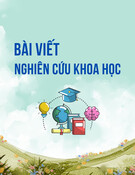
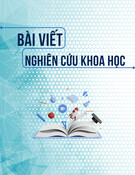
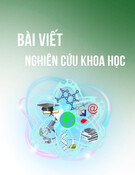






![Bộ câu hỏi trắc nghiệm Văn bản tiếng Việt [chuẩn nhất]](https://cdn.tailieu.vn/images/document/thumbnail/2025/20251127/thuynhung051106@gmail.com/135x160/24021764296609.jpg)
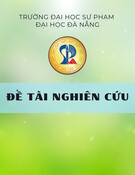

![Bài giảng Ngôn ngữ học đối chiếu Nguyễn Ngọc Chinh [PDF]](https://cdn.tailieu.vn/images/document/thumbnail/2025/20251101/vovu03/135x160/7471762139652.jpg)

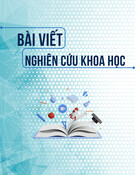
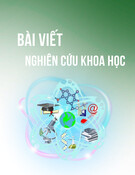

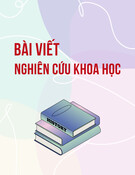
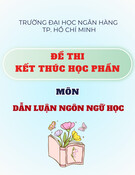

![Ngân hàng câu hỏi môn Tiếng Việt thực hành [chuẩn nhất]](https://cdn.tailieu.vn/images/document/thumbnail/2025/20251003/kimphuong1001/135x160/21861759464951.jpg)
![Bài giảng Văn học phương Tây và Mỹ Latinh [Tập hợp]](https://cdn.tailieu.vn/images/document/thumbnail/2025/20251003/kimphuong1001/135x160/31341759476045.jpg)

